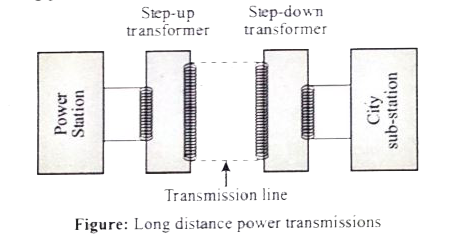Give the advantage of AC in long distance power transmission w ith an example.Solution in Tamil
Advantages of AC in long distance power transmission: Electric power is produced in a large scale at electric power stations with the help of AC generators. These power stations are classified based on the txpe of fuel used as thermal, hydro electric and nuclear pow er stations. Most of these stations are located at remote places. Hence the electric power generated is transmitted over long distances through transmission lines to reach towns or cities where it is actually consumed. This process is called power transmission. But there is a difficulty during power transmission. A sizable fraction of electric pow.er is lost due to Joule heating (rR) in the transmission lines which are hundreds of kilometer long. This power loss can be tackled either by reducing current i or by reducing resistance R of the transmission lines. The resistance R can be reduced with thick w.ires of copper or aluminium. But this increases the cost of production of transmission lines and other related expenses. So this way of reducing power loss is not economically viable.

Since power produced is alternating in nature, there is a way out. The most important property of alternating voltage is that it can be stepped up and stepped down by using transformers could be exploited in reducing current and thereby reducing pow.er losses to a greater extent. At the transmitting point, the voltage is increased and the corresponding current is decreased by using step-up transformer. Then it is transmitted through transmission lines. This reduced current at high voltage reaches the destination without any appreciable loss. At the receiving point, the voltage is decreased and the current is increased to appropriate values by using step-down transformer and then it is given to consumers. Thus power transmission is done efficiently and economically.
Illustration: An electric power of 2 MW is transmitted to a place through transmission lines of total resistance, say R = 40 Ω, at two different voltages. One is lower voltage (10 kV) and the other is higher (100 kV). Let us now calculate and compare power losses in these two cases. Case (i): P = 2 MW, R = 40 Ω, V = 10 kV
Power , P=VI
∴ Current, I=PV=2×10610×103=200A
Power loss = Heat produced - I2R−(200)2×40=1.6×106W
% of power loss= 1.6×1062×106×100%=0.8×100%−80%
Case (ii): P = 2 MW, R= 40 Ω, V = 100 kV
∴ Current, I=PV=2×106100×103=20A
Power loss - float produce - I2R=(20)2×40=0.016×106W
% Power Loss =0.016×1062×106×100%=0.8%
Topper's Solved these Questions
- SAMPLE PAPER -10 (SOLVED)Book:FULL MARKSChapter:SAMPLE PAPER -10 (SOLVED)Exercise:PART - III
Explore 9 Videos
- SAMPLE PAPER - 20 (UNSOLVED)Book:FULL MARKSChapter:SAMPLE PAPER - 20 (UNSOLVED)Exercise:PART - IV
Explore 10 Videos
- SAMPLE PAPER -12Book:FULL MARKSChapter:SAMPLE PAPER -12Exercise:PART-IV
Explore 10 Videos
Similar Questions
Define electrostatic potential energy.
View SolutionDerive an expression for electrostatic potential due to an electric dipole.
View SolutionObtain the expression for the energy stored in a parallel plate capacitor.
View SolutionLong Distance Power Transmission
View SolutionIs it necessary to use satellite for long distance T.V. transmission? Give reasons.
View SolutionLong distance power transmission is carried on high voltage line. Why ?
View SolutionFor long distance transmission , the AC is stepped up because at high voltage , the transmission is
View SolutionGive the advantage of AC in long distance power transmission w ith an example.
View SolutionExplain the use of transformer in long distance transmission of electric power .
View SolutionMention the advantage of A.C. over D.C. for long distance transmission.
View Solutiona.c. power is transmitted over long distances at voltages so that power loss during transmission is ………
View SolutionGive scientific reasons for the following statements :
We use AC for electric power transmission over long distance , while most of the appliances use DC.
View SolutionGive reason for the following, satellite are used for long distance TV transmission
View SolutionFor long distance transmission, the ac is stepped up because transmission at high voltage is :
View SolutionWhat is the advantage of using a transformer for long distance transmission of electrical energy?
View Solution

